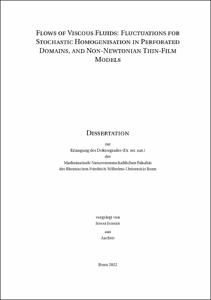Jansen, Jonas: Flows of Viscous Fluids: Fluctuations for Stochastic Homogenisation in Perforated Domains, and Non-Newtonian Thin-Film Models. - Bonn, 2022. - Dissertation, Rheinische Friedrich-Wilhelms-Universität Bonn.
Online-Ausgabe in bonndoc: https://nbn-resolving.org/urn:nbn:de:hbz:5-67968
Online-Ausgabe in bonndoc: https://nbn-resolving.org/urn:nbn:de:hbz:5-67968
@phdthesis{handle:20.500.11811/10299,
urn: https://nbn-resolving.org/urn:nbn:de:hbz:5-67968,
author = {{Jonas Jansen}},
title = {Flows of Viscous Fluids: Fluctuations for Stochastic Homogenisation in Perforated Domains, and Non-Newtonian Thin-Film Models},
school = {Rheinische Friedrich-Wilhelms-Universität Bonn},
year = 2022,
month = sep,
note = {This thesis concerns problems arising in the study of flows of viscous fluids. In the first part, we discuss the interaction of the flow of a viscous fluid with a random array of moving particles in the limit of many particles and a total Stokes drag of order one. The second part of this thesis analyses the dynamics of thin liquid films of non-Newtonian fluids driven by capillary forces.
The description of an effective theory of a random array of moving particles in a viscous fluid is known as stochastic homogenisation in perforated domains. If the particles move slowly, inertial effects can be neglected and the fluid flow can be described as a Stokes flow in a perforated domain. Due to the viscous nature of the fluid, the interaction of the particles through the fluid is of long range. The Brinkman equations describe the effective theory for the fluid flow in the limit of many particles so that the collective Stokes drag is of order one. The rigorous derivation of the Brinkman equations from a Stokes flow in a perforated domain has been an active area of research.
This thesis addresses the quantitative study of the homogenisation result for the Stokes flow in perforated domains. For a random configuration of particles and velocities, the fluctuations around the limit are analysed. In the physical setting of three space dimensions, the fluctuation field is derived explicitly, and convergence rates for an approximation of the velocity fields in the perforated domains are shown. Furthermore, this thesis takes a first glance at a connection between stochastic homogenisation in perforated domains and stochastic partial differential equations.
The dynamic behaviour of thin liquid films of viscous fluids is derived from an asymptotic expansion in terms of the film height of a free-boundary Navier--Stokes system in the lubrication approximation. If the dynamics of the thin film are determined only from viscous forces and surface tension, the evolution of the film height is, to leading order, described by a fourth-order nonlinear degenerate-parabolic partial differential equation. In the second part of this thesis, the long-time behaviour and stability of this thin-film equation is studied for different non-Newtonian rheologies. That the evolution of the film height only depends on viscous and capillary forces points towards a gradient-flow structure of the dynamics. The decay rates depend on the fluid rheology. This topic is addressed in the final chapter of this thesis, where the gradient-flow structure of thin films of non-Newtonian power-law fluids with general mobilities is studied.},
url = {https://hdl.handle.net/20.500.11811/10299}
}
urn: https://nbn-resolving.org/urn:nbn:de:hbz:5-67968,
author = {{Jonas Jansen}},
title = {Flows of Viscous Fluids: Fluctuations for Stochastic Homogenisation in Perforated Domains, and Non-Newtonian Thin-Film Models},
school = {Rheinische Friedrich-Wilhelms-Universität Bonn},
year = 2022,
month = sep,
note = {This thesis concerns problems arising in the study of flows of viscous fluids. In the first part, we discuss the interaction of the flow of a viscous fluid with a random array of moving particles in the limit of many particles and a total Stokes drag of order one. The second part of this thesis analyses the dynamics of thin liquid films of non-Newtonian fluids driven by capillary forces.
The description of an effective theory of a random array of moving particles in a viscous fluid is known as stochastic homogenisation in perforated domains. If the particles move slowly, inertial effects can be neglected and the fluid flow can be described as a Stokes flow in a perforated domain. Due to the viscous nature of the fluid, the interaction of the particles through the fluid is of long range. The Brinkman equations describe the effective theory for the fluid flow in the limit of many particles so that the collective Stokes drag is of order one. The rigorous derivation of the Brinkman equations from a Stokes flow in a perforated domain has been an active area of research.
This thesis addresses the quantitative study of the homogenisation result for the Stokes flow in perforated domains. For a random configuration of particles and velocities, the fluctuations around the limit are analysed. In the physical setting of three space dimensions, the fluctuation field is derived explicitly, and convergence rates for an approximation of the velocity fields in the perforated domains are shown. Furthermore, this thesis takes a first glance at a connection between stochastic homogenisation in perforated domains and stochastic partial differential equations.
The dynamic behaviour of thin liquid films of viscous fluids is derived from an asymptotic expansion in terms of the film height of a free-boundary Navier--Stokes system in the lubrication approximation. If the dynamics of the thin film are determined only from viscous forces and surface tension, the evolution of the film height is, to leading order, described by a fourth-order nonlinear degenerate-parabolic partial differential equation. In the second part of this thesis, the long-time behaviour and stability of this thin-film equation is studied for different non-Newtonian rheologies. That the evolution of the film height only depends on viscous and capillary forces points towards a gradient-flow structure of the dynamics. The decay rates depend on the fluid rheology. This topic is addressed in the final chapter of this thesis, where the gradient-flow structure of thin films of non-Newtonian power-law fluids with general mobilities is studied.},
url = {https://hdl.handle.net/20.500.11811/10299}
}






